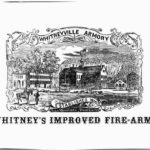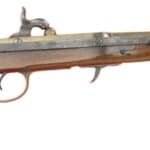
Introduction
Out on the American frontier and across the battlefields of the 19th century, one musket stood tall—the U.S. Model 1842 Musket. More than just a firearm, it was a milestone in industrial history, the first standard-issue U.S. military musket to feature fully interchangeable parts. From the Mexican-American War to the American Civil War, this weapon played a key role in shaping U.S. military tactics and manufacturing.
In this deep dive, we’ll explore the construction, performance, historical significance, and impact of the Model 1842, backed by primary sources, ballistics data, and historical accounts. Whether you're a history buff, a collector, or an enthusiast of early American firearms, this is the most comprehensive guide to the U.S. Model 1842 Musket you'll find.
Origins and Development of the Model 1842 Musket
A New Era of Firearm Manufacturing
Before the Model 1842, military muskets were largely handcrafted, with parts that varied slightly from one weapon to another. This made repairs and maintenance difficult, requiring skilled armorers to hand-fit replacement parts. Recognizing the inefficiency of this system, the U.S. Ordnance Department sought to standardize firearm production using fully interchangeable parts.
This concept had been pioneered earlier with the Model 1819 Hall Rifle and later seen in the Model 1841 Mississippi Rifle, but the Model 1842 Musket was the first widely issued standard military musket to fully embrace this technological leap.
Manufacturing and Production
The Model 1842 Musket was produced at two primary locations:
- Springfield Armory (Massachusetts)
- Harpers Ferry Armory (Virginia)
Between 1844 and 1855, approximately 275,000 units were manufactured (Springfield Armory Records, 1855). This large-scale production ensured a consistent and reliable firearm for U.S. forces.
Design and Construction
Caliber and Barrel
The Model 1842 was chambered in .69 caliber, a holdover from earlier smoothbore muskets like the Model 1816. The large bore diameter provided substantial stopping power, though at the cost of accuracy beyond short distances.
- Barrel Length: 42 inches
- Overall Length: 58 inches
- Weight: Approximately 10 lbs (unloaded)
- Smoothbore Design: Easier to load but less accurate than later rifled models
Percussion Cap Ignition
One of the biggest advancements over previous flintlock muskets was the percussion cap system. This innovation significantly improved reliability, particularly in wet or humid conditions where flintlocks often failed.
- How It Works: A small percussion cap, containing a shock-sensitive compound, was placed on the musket’s nipple. When struck by the hammer, the cap detonated, igniting the powder charge in the barrel.
- Advantages Over Flintlock: Faster ignition, fewer misfires, better performance in adverse weather.
According to James M. McPherson’s analysis in Battle Cry of Freedom (Oxford University Press, 1988), soldiers appreciated the increased reliability of the percussion system, which gave them an edge in battle.
Stock and Materials
The Model 1842 Musket featured a walnut stock, which was oil-finished for moisture resistance. The barrel and lock were made from forged iron, left in a “bright” finish rather than blued. Brass was used for trigger guards and buttplates in some variations.
Ballistics and Performance
Ammunition and Loading Procedure
Standard ammunition consisted of a .69 caliber round ball, typically wrapped in a greased paper cartridge. Later, Minié ball ammunition was introduced for rifled conversions, significantly increasing range and accuracy.
- Powder Charge: 110-120 grains of black powder
- Muzzle Velocity: ~1,500 fps (for round ball)
- Effective Range (Smoothbore): 50-75 yards
- Effective Range (Rifled Conversion): 200-300 yards
- Rate of Fire: 2-3 rounds per minute
Smoothbore vs. Rifled Conversions
Many Model 1842 Muskets were later rifled and fitted with rear sights, allowing them to fire Minié balls—a revolutionary conical projectile. These rifled variants were capable of effective fire at more than 300 yards, bridging the gap between old smoothbores and the more advanced Model 1855 Springfield Rifle-Musket.
Combat History and Legacy
Mexican-American War (1846-1848)
The Model 1842 saw extensive action in battles such as Buena Vista and Chapultepec, where its ruggedness and reliability made it a trusted weapon for American troops. Despite its limited range, it was effective in massed volley fire tactics, typical of 19th-century warfare.
American Civil War (1861-1865)
By the Civil War, rifled muskets were becoming the norm, but the Model 1842 was still in widespread use, particularly in Confederate ranks, due to shortages of newer weapons.
- Confederate troops, especially early in the war, relied heavily on captured or stockpiled Model 1842 Muskets.
- Union forces often relegated them to rear-line units or militias, as rifled muskets became standard for frontline troops.
According to U.S. Ordnance Reports (1863), thousands of Model 1842 Muskets were still actively used throughout the war, with many being rifled for greater range.
Why the Model 1842 Musket Mattered
The U.S. Model 1842 Musket was more than just another military firearm—it was a technological milestone that ushered in a new era of precision manufacturing. It proved the feasibility of interchangeable parts, laying the groundwork for modern assembly-line production.
Additionally, its percussion cap system paved the way for the rapid evolution of military firearms, leading to the widespread adoption of rifled muskets and breech-loading rifles in the decades that followed.
Conclusion
The U.S. Model 1842 Musket remains an iconic weapon in American history. It was the last smoothbore musket issued to U.S. troops and the first firearm produced with fully interchangeable parts, making it a crucial link between old-world craftsmanship and industrialized arms manufacturing.
Whether carried by American troops storming the hills of Mexico, defending the fields of Gettysburg, or standing in arsenals as the nation transitioned to modern warfare, the Model 1842 Musket earned its place in history.
A relic of its time? Maybe. But an innovation that shaped the future of firearms? Absolutely.
Further Reading and Sources
U.S. Army Historical Division - Military Small Arms of the 19th Century
Springfield Armory Historical Records (1855) - Springfield Armory
U.S. Ordnance Reports, 1863 - National Archives
McPherson, J. (1988). Battle Cry of Freedom. Oxford University Press.
If you'd like to join a forum to enjoy discussions on this and other Muzzleloaders, click here.
If you know of any forums or sites that should be referenced on this listing, please let us know here.



